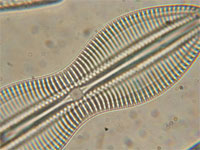 |
|||||
 |
 |
||||
 |
|||||
 |
 |
||||
Carl Zeiss Compound Microscope (No. 329) |
|||||||||
 |
Age: 1907 Made by: Carl Zeiss, Jena Made in: Germany |
||||||||
 |
|||||||||
|
The Carl Zeiss logo was filed for patent in 1904 and introduced in products in 1906. Its design is based on the Tessar achromatic objective.
|
|||||||||
 |
|||||||||
|
Imaging
|
|||||||||
|
This microscope is a Carl Zeiss (Jena) Model IIId monocular microscope, SN 45932 made in 1907*. It is a black lacquered upright compound microscope with a compass joint and a horseshoe base. The stand has an oval cutout for handling the instrument, which is the source of the nickname "jug-handle". It has a rotating stage with two slide clips. The stage has no vernier. The rotating nosepiece is made of white metal and has three positions. Focus is via a rack and pinion (coarse) and a Berger fine focus mechanism. There are two eyepieces with this microscope labeled "2" and "4". The condenser is an Abbe-type with an additional upper iris diaphragm. There are three objectives, two Zeiss and one Leica. Illumination is provided by a two-sided mirror (plane and parabolic). Imaging is very good except for a minor amount of chromatic aberration. The microscope is 37cm tall. The instrument and accessories can be stored in a fruit wood case.
This instrument was donated by Prof Emeritus G. Steven Martin. *ZEISS microscope 45932 was delivered on 25th October 1907 to Carl Zeiss London as stand IIID without optical equipment, thus all the optics were most probably supplied by the lenses in stock in London. T. Mappes Featured 03/2020 |
|||||||||